 Technology peripherals
Technology peripherals
 AI
AI
 Google reuses classic algorithms from 30 years ago, and CV introduces reinforcement learning. Netizens: Is visual RLHF coming?
Google reuses classic algorithms from 30 years ago, and CV introduces reinforcement learning. Netizens: Is visual RLHF coming?
Google reuses classic algorithms from 30 years ago, and CV introduces reinforcement learning. Netizens: Is visual RLHF coming?
The popularity of ChatGPT is obvious to all, and for the technology behind its success, supervised instruction fine-tuning and reinforcement learning based on human feedback are crucial. These techniques are also gradually expanding into other AI fields, including computer vision (CV).
We know that when dealing with complex output in computer vision, the main criterion for success is not how well the model optimizes the training target, but how well the prediction ability matches the task. That is, how well the model performs for its intended use.
In order to pursue this consistency, some researchers have made some improvements in model architecture, data, optimization, sampling, post-processing, etc. For example, in the object detection task, researchers used NMS (non-maximum suppression), set-based global loss, and changing the input data to obtain models with improved behavior at test time. Although these methods bring significant benefits, they are often only useful for specific tasks and only indirectly optimize mission risks.
Not only CV, but also natural language processing (NLP), reinforcement learning (RL) and other fields are also extensively studying this phenomenon. In these domains, it is very difficult to formulate optimization goals for less well-defined tasks, such as translation or summarization generation. When dealing with this type of problem, A popular approach is to learn to imitate the output of the example and then perform reinforcement learning to align the model with the reward function. The field of NLP has produced exciting results using this approach, which uses large pre-trained language models and rewards defined by human feedback to tackle otherwise difficult-to-specify tasks.
Furthermore, the same method is widely used in image captioning tasks, where CIDEr (proposed by Vedantam et al. 2015) is used as reward. Nonetheless, to the best of our knowledge, reward optimization has not been previously explored in (non-textual) computer vision tasks.
Recently, researchers from the Google Brain team demonstrated in the paper "Tuning computer vision models with task rewards" that uses the REINFORCE algorithm (proposed by Williams in 1992) Tuning pre-trained models with reward functions can be used out of the box for a variety of computer vision tasks.
In fact, many studies on reinforcement learning tasks will mention Williams' REINFORCE algorithm, which shows the importance of this algorithm. It can be said that the REINFORCE algorithm is a typical representative of policy gradient and even reinforcement learning.
Paper address: https://arxiv.org/pdf/2302.08242v1.pdf
Figure 1 Some key results are presented, mainly including quantitative and qualitative improvements resulting from reward optimization in object detection, panoramic segmentation, and image colorization. The method proposed in this study is simple and effective in handling various CV tasks, demonstrating its versatility and adaptability. Although this paper mainly uses rewards in the form of evaluation metrics, these preliminary results show that this method can also be an effective way to optimize computer vision models that have more complex and difficult to specify rewards, such as human feedback or overall systems. performance.
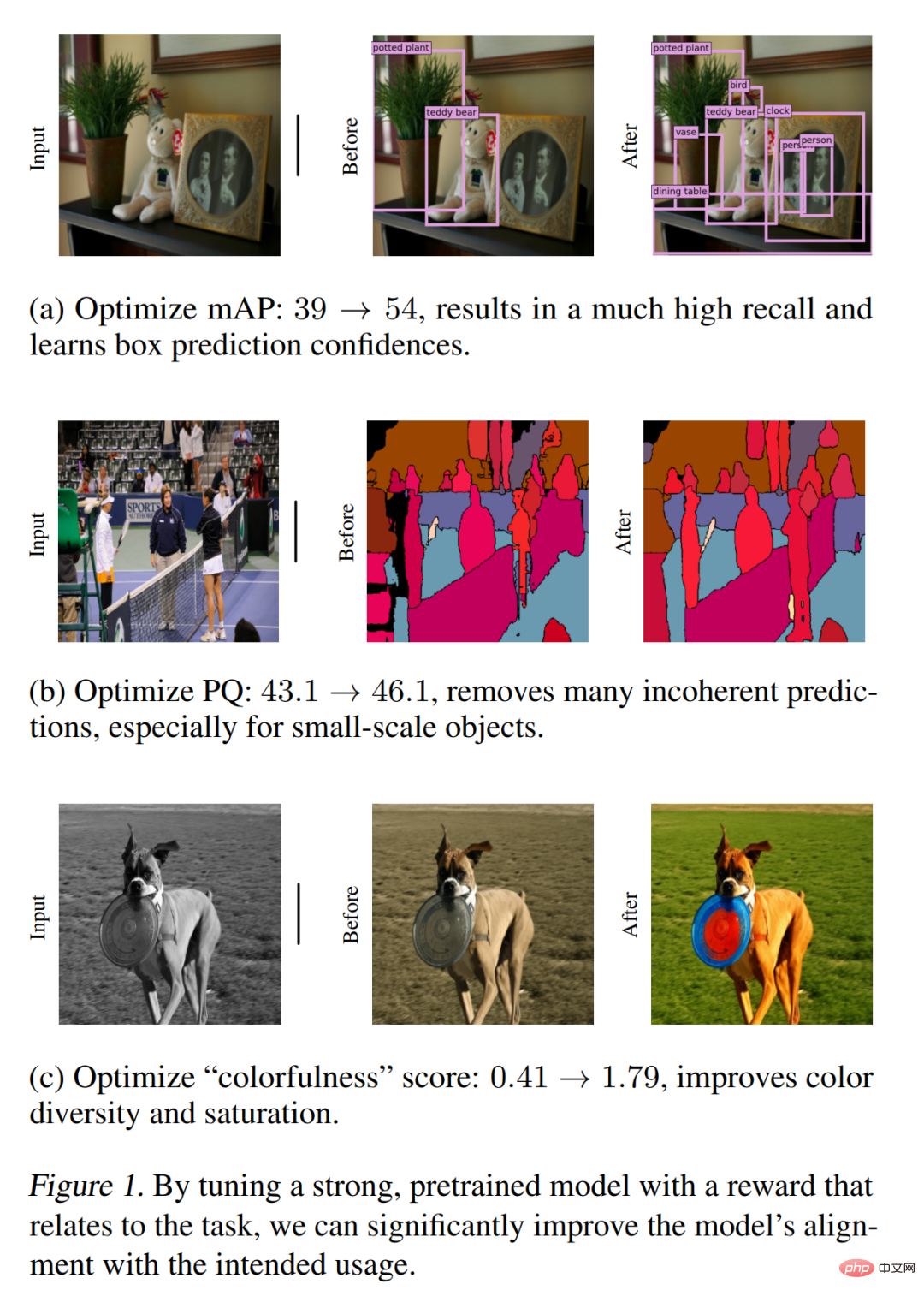
Twitter netizens gave a relatively comprehensive summary of this article, that is, the function implemented in this article is to use RL to adjust the pre-trained visual model. The motivation for the research was inspired by the success of LLM reinforcement learning; the effect was a significant improvement in performance in target detection, panoramic segmentation, etc. He also stated that this research may be an effective way to achieve visual RLHF (Reinforcement Learning from Human Feedback).

## Source: https://twitter.com/johnjnay/status /1627009121378598912
Reward
Without losing generalization, this study describes the CV task as the process of learning a function that maps the input x (i.e., the image) to the output y = [y_1, y_1,..., y_n] (text token sequence, bounding box sequence, etc.). This research aims to learn a conditional distribution P (y|x, θ) with θ as a parameter to maximize the reward function R. To use an abstract formula to describe it, this article will solve the following optimization problems.

The problem is there, and the next step is how to solve it. This article is divided into two steps: first, use maximum likelihood estimation Pre-train the model; then use the REINFORCE algorithm to tune the model. Let’s take a look at the specific process of these two steps:
##Maximum likelihood pre-training
The parameters θ are first estimated using the maximum likelihood principle and the distribution of the training data is captured. This is accomplished using the gradient descent algorithm, which works by maximizing the log-likelihood
 of the training data. Algorithm 1 and Figure 2 describe the MLE (maximum likelihood estimation) optimization step, which is the most common method for training models. Completing this step will result in an MLE model.
of the training data. Algorithm 1 and Figure 2 describe the MLE (maximum likelihood estimation) optimization step, which is the most common method for training models. Completing this step will result in an MLE model.
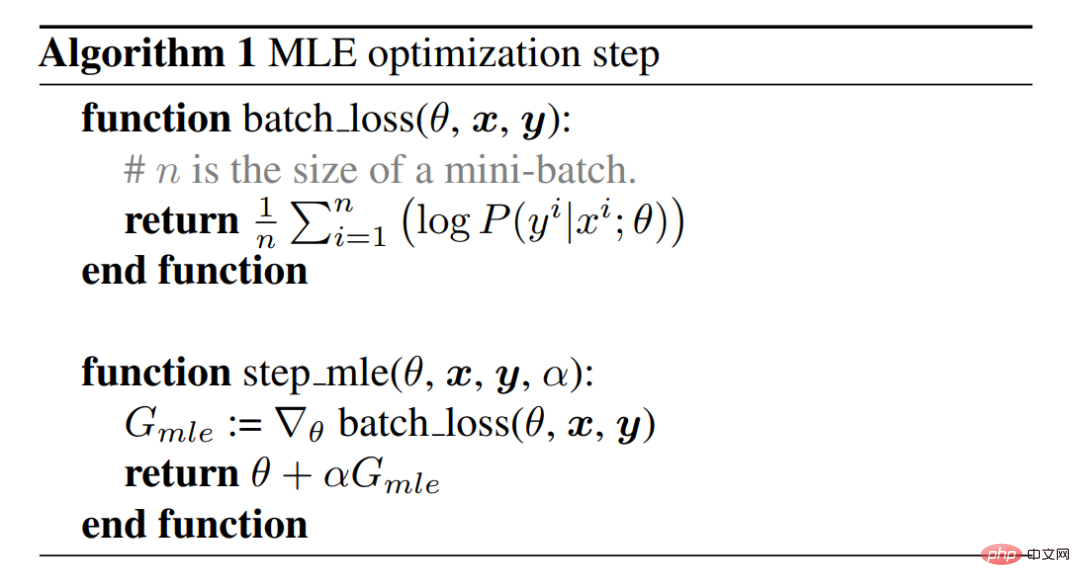
##REINFORC algorithm maximizes rewards
In order to better optimize the MLE model to adapt to task risks, it is also necessary to maximize the reward function. For a given input x, this study uses the REINFORCE algorithm to estimate the gradient of the expected reward for a given x. The formula is as follows:

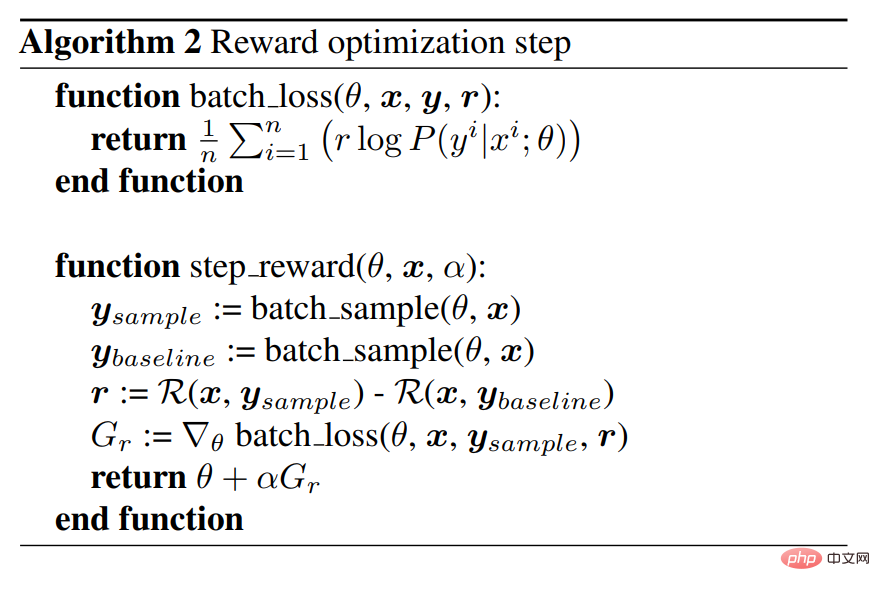
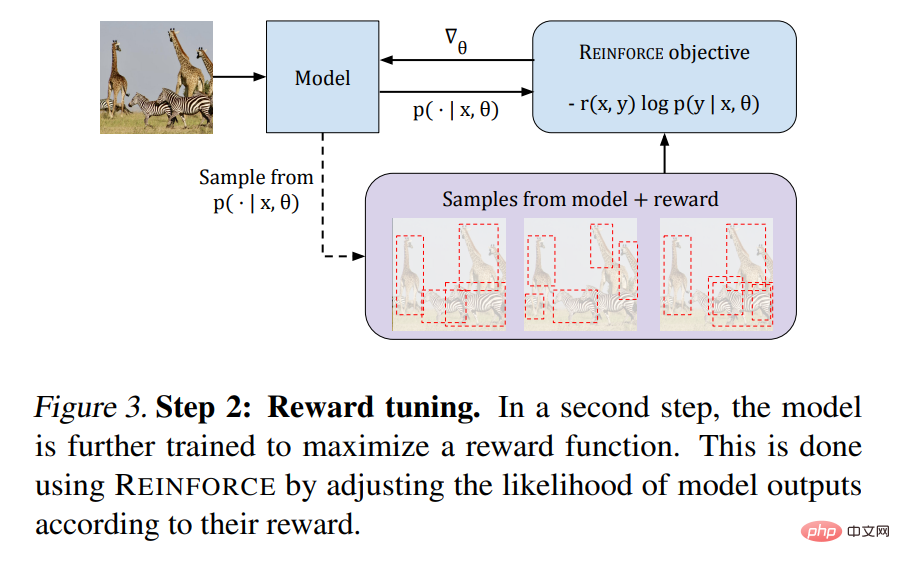 ##Experimental results
##Experimental results
Next, let’s take a look at the performance of the method proposed in this article on visual tasks.
Panoramic Segmentation
As shown in Table 1 below, the Tuning process significantly improves the MLE model. Results after visual inspection show that the model after Tuning is better at avoiding incoherent predictions, especially for small-scale objects, see Figure 1.
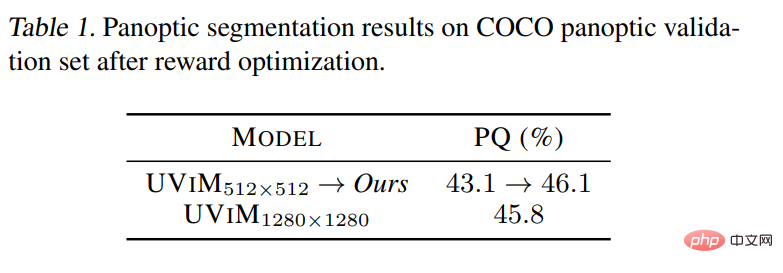
Table 2 shows that through optimization, this study significantly improved the mAP score of the original MLE model from 39.2% to 54.3%. In Pix2seq, the same-sized ViT-B model with a slightly larger 1333×1333 resolution and many heuristics achieved 47.1%. When using the larger ViT-L backbone, Pix2seq reported the best target detection result of 50.0%.

The qualitative results presented in Figure 4 clearly show that the new model consistently produces more colorful images. 
Image description

Table 3 results show that applying the proposed method can improve the MLE model, which is consistent with previous observations in the literature, demonstrating the effectiveness of this method for tuning for specific task risks.
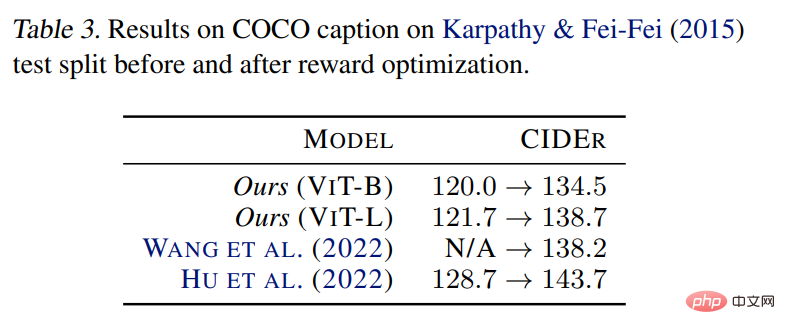
The above is the detailed content of Google reuses classic algorithms from 30 years ago, and CV introduces reinforcement learning. Netizens: Is visual RLHF coming?. For more information, please follow other related articles on the PHP Chinese website!

Hot AI Tools

Undresser.AI Undress
AI-powered app for creating realistic nude photos

AI Clothes Remover
Online AI tool for removing clothes from photos.

Undress AI Tool
Undress images for free

Clothoff.io
AI clothes remover

AI Hentai Generator
Generate AI Hentai for free.

Hot Article

Hot Tools

Notepad++7.3.1
Easy-to-use and free code editor

SublimeText3 Chinese version
Chinese version, very easy to use

Zend Studio 13.0.1
Powerful PHP integrated development environment

Dreamweaver CS6
Visual web development tools

SublimeText3 Mac version
God-level code editing software (SublimeText3)

Hot Topics
 1384
1384
 52
52
 The world's most powerful open source MoE model is here, with Chinese capabilities comparable to GPT-4, and the price is only nearly one percent of GPT-4-Turbo
May 07, 2024 pm 04:13 PM
The world's most powerful open source MoE model is here, with Chinese capabilities comparable to GPT-4, and the price is only nearly one percent of GPT-4-Turbo
May 07, 2024 pm 04:13 PM
Imagine an artificial intelligence model that not only has the ability to surpass traditional computing, but also achieves more efficient performance at a lower cost. This is not science fiction, DeepSeek-V2[1], the world’s most powerful open source MoE model is here. DeepSeek-V2 is a powerful mixture of experts (MoE) language model with the characteristics of economical training and efficient inference. It consists of 236B parameters, 21B of which are used to activate each marker. Compared with DeepSeek67B, DeepSeek-V2 has stronger performance, while saving 42.5% of training costs, reducing KV cache by 93.3%, and increasing the maximum generation throughput to 5.76 times. DeepSeek is a company exploring general artificial intelligence
 AI subverts mathematical research! Fields Medal winner and Chinese-American mathematician led 11 top-ranked papers | Liked by Terence Tao
Apr 09, 2024 am 11:52 AM
AI subverts mathematical research! Fields Medal winner and Chinese-American mathematician led 11 top-ranked papers | Liked by Terence Tao
Apr 09, 2024 am 11:52 AM
AI is indeed changing mathematics. Recently, Tao Zhexuan, who has been paying close attention to this issue, forwarded the latest issue of "Bulletin of the American Mathematical Society" (Bulletin of the American Mathematical Society). Focusing on the topic "Will machines change mathematics?", many mathematicians expressed their opinions. The whole process was full of sparks, hardcore and exciting. The author has a strong lineup, including Fields Medal winner Akshay Venkatesh, Chinese mathematician Zheng Lejun, NYU computer scientist Ernest Davis and many other well-known scholars in the industry. The world of AI has changed dramatically. You know, many of these articles were submitted a year ago.
 Google is ecstatic: JAX performance surpasses Pytorch and TensorFlow! It may become the fastest choice for GPU inference training
Apr 01, 2024 pm 07:46 PM
Google is ecstatic: JAX performance surpasses Pytorch and TensorFlow! It may become the fastest choice for GPU inference training
Apr 01, 2024 pm 07:46 PM
The performance of JAX, promoted by Google, has surpassed that of Pytorch and TensorFlow in recent benchmark tests, ranking first in 7 indicators. And the test was not done on the TPU with the best JAX performance. Although among developers, Pytorch is still more popular than Tensorflow. But in the future, perhaps more large models will be trained and run based on the JAX platform. Models Recently, the Keras team benchmarked three backends (TensorFlow, JAX, PyTorch) with the native PyTorch implementation and Keras2 with TensorFlow. First, they select a set of mainstream
 Hello, electric Atlas! Boston Dynamics robot comes back to life, 180-degree weird moves scare Musk
Apr 18, 2024 pm 07:58 PM
Hello, electric Atlas! Boston Dynamics robot comes back to life, 180-degree weird moves scare Musk
Apr 18, 2024 pm 07:58 PM
Boston Dynamics Atlas officially enters the era of electric robots! Yesterday, the hydraulic Atlas just "tearfully" withdrew from the stage of history. Today, Boston Dynamics announced that the electric Atlas is on the job. It seems that in the field of commercial humanoid robots, Boston Dynamics is determined to compete with Tesla. After the new video was released, it had already been viewed by more than one million people in just ten hours. The old people leave and new roles appear. This is a historical necessity. There is no doubt that this year is the explosive year of humanoid robots. Netizens commented: The advancement of robots has made this year's opening ceremony look like a human, and the degree of freedom is far greater than that of humans. But is this really not a horror movie? At the beginning of the video, Atlas is lying calmly on the ground, seemingly on his back. What follows is jaw-dropping
 KAN, which replaces MLP, has been extended to convolution by open source projects
Jun 01, 2024 pm 10:03 PM
KAN, which replaces MLP, has been extended to convolution by open source projects
Jun 01, 2024 pm 10:03 PM
Earlier this month, researchers from MIT and other institutions proposed a very promising alternative to MLP - KAN. KAN outperforms MLP in terms of accuracy and interpretability. And it can outperform MLP running with a larger number of parameters with a very small number of parameters. For example, the authors stated that they used KAN to reproduce DeepMind's results with a smaller network and a higher degree of automation. Specifically, DeepMind's MLP has about 300,000 parameters, while KAN only has about 200 parameters. KAN has a strong mathematical foundation like MLP. MLP is based on the universal approximation theorem, while KAN is based on the Kolmogorov-Arnold representation theorem. As shown in the figure below, KAN has
 Tesla robots work in factories, Musk: The degree of freedom of hands will reach 22 this year!
May 06, 2024 pm 04:13 PM
Tesla robots work in factories, Musk: The degree of freedom of hands will reach 22 this year!
May 06, 2024 pm 04:13 PM
The latest video of Tesla's robot Optimus is released, and it can already work in the factory. At normal speed, it sorts batteries (Tesla's 4680 batteries) like this: The official also released what it looks like at 20x speed - on a small "workstation", picking and picking and picking: This time it is released One of the highlights of the video is that Optimus completes this work in the factory, completely autonomously, without human intervention throughout the process. And from the perspective of Optimus, it can also pick up and place the crooked battery, focusing on automatic error correction: Regarding Optimus's hand, NVIDIA scientist Jim Fan gave a high evaluation: Optimus's hand is the world's five-fingered robot. One of the most dexterous. Its hands are not only tactile
 FisheyeDetNet: the first target detection algorithm based on fisheye camera
Apr 26, 2024 am 11:37 AM
FisheyeDetNet: the first target detection algorithm based on fisheye camera
Apr 26, 2024 am 11:37 AM
Target detection is a relatively mature problem in autonomous driving systems, among which pedestrian detection is one of the earliest algorithms to be deployed. Very comprehensive research has been carried out in most papers. However, distance perception using fisheye cameras for surround view is relatively less studied. Due to large radial distortion, standard bounding box representation is difficult to implement in fisheye cameras. To alleviate the above description, we explore extended bounding box, ellipse, and general polygon designs into polar/angular representations and define an instance segmentation mIOU metric to analyze these representations. The proposed model fisheyeDetNet with polygonal shape outperforms other models and simultaneously achieves 49.5% mAP on the Valeo fisheye camera dataset for autonomous driving
 The latest from Oxford University! Mickey: 2D image matching in 3D SOTA! (CVPR\'24)
Apr 23, 2024 pm 01:20 PM
The latest from Oxford University! Mickey: 2D image matching in 3D SOTA! (CVPR\'24)
Apr 23, 2024 pm 01:20 PM
Project link written in front: https://nianticlabs.github.io/mickey/ Given two pictures, the camera pose between them can be estimated by establishing the correspondence between the pictures. Typically, these correspondences are 2D to 2D, and our estimated poses are scale-indeterminate. Some applications, such as instant augmented reality anytime, anywhere, require pose estimation of scale metrics, so they rely on external depth estimators to recover scale. This paper proposes MicKey, a keypoint matching process capable of predicting metric correspondences in 3D camera space. By learning 3D coordinate matching across images, we are able to infer metric relative



